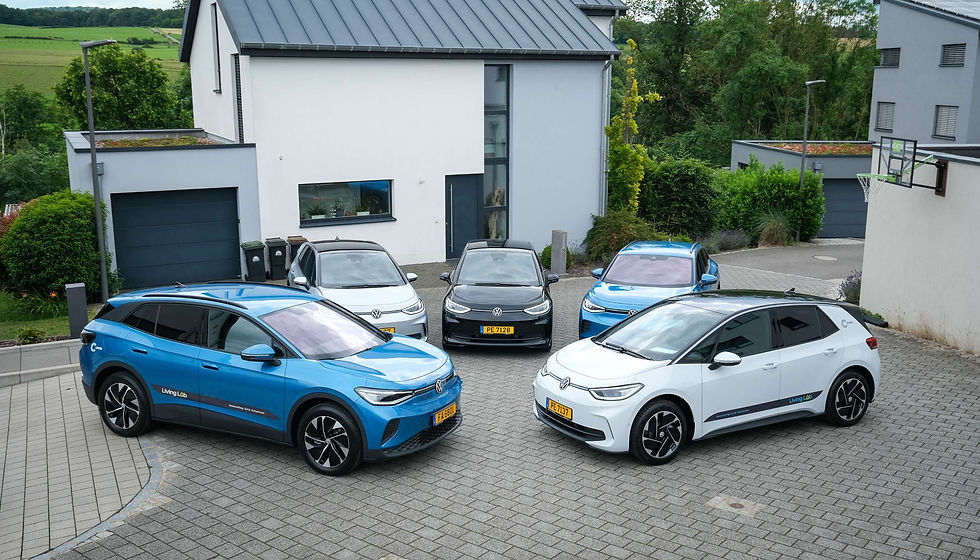Creos Living Lab, Part 1 — Getting Ready to Listen (prep, journeys, household interviews)
- David Everard

- May 24, 2024
- 4 min read
Updated: Oct 19
A pilot begins long before the sensors switch on.
For Creos, the Living Lab wasn’t just hardware and dashboards—it was people, routines, questions, hopes. Our brief at EVERARD was to make that human layer visible and usable: help shape the story and the touchpoints, translate engineering into everyday language, and design a way of listening that would stand up to a year of real life.

Why a Living Lab (in plain words)
Luxembourg’s energy transition is speeding up. More heat pumps, more EVs, more rooftop solar—more load and variability on the low-voltage grid. The Living Lab is Creos’ way to test, in one real street, how technology, daily habits, and grid operations can work together for a resilient system. Smart-grid tools (including a digital twin of the local network) and phased behaviour trials would let the team simulate “2030 conditions” safely and learn with residents, not just about them.

Our role (quietly practical)
We supported Creos on three fronts:
Meaning & messaging. Co-crafting language and visuals so that goals like “peak shifting” and “self-consumption” simply made sense at kitchen-table level. (No jargon; clear asks; honest benefits & trade-offs.)
Journeys & touchpoints. Designing a participant experience that feels respectful and predictable—from first contact to installation, from in-app prompts to monthly feedback.
Ground truth. Sitting down with households—50+ interviews across four pre-identified streets—to understand routines, constraints, and willingness to try small changes (e.g., moving EV charging or laundry). Those conversations, and the reports that followed, helped Creos select the pilot street in Cruchten (near Mersch) and shape the first-year communication and support.
The Living Lab is about aligning three levers: smart infrastructure, useful digital tools at home, and small everyday gestures that ease peaks and value local solar. We kept that triangle front and centre in every page and every visit.
From empathy maps to journeys
Before we knocked on doors, we ran a Customer Journey Workshop that built on an empathy-mapping session. We worked with three “true-to-life” personas—reluctant, enthusiastic, unpredictable, and motivated, methodical. Each persona exposed different needs:
Clarity & control (What changes? What’s the ask? Can I override?)
Trust & privacy (Who sees my data? What for? For how long?)
Convenience (Prompts that fit real schedules; no “gotchas” at 7:30 a.m.)
Mapping these through the journey—invite → onboarding → install → daily nudges → monthly feedback—gave us the “red threads” to test in the field.

The questionnaire we carried to the doorstep
Together with the Creos team, we built a long-form, plain-language questionnaire—modular, so it felt like a conversation, not a form.
It covered:
Home & habits: heating, hot-water, typical laundry/cooking times, EV patterns.
Flex windows: what could shift to midday (solar) or off-peak evenings, and what could not.
Digital comfort: app notifications, automation boundaries, and “do-not-disturb” hours.
Fairness & feedback: what a “good deal” looks like (comfort unchanged, cost neutral or better, effort small), and the type of progress updates people value.
We tested wording with Creos engineers to keep it technically meaningful—and with non-engineers to keep it human.
The listening tour: four candidate streets
Across four shortlisted streets, we met residents where they are—on the doorstep, at the dining table, in driveways near charge cables. Patterns emerged:
Flexibility is real—but specific. People will move a dishwasher or an EV charge, if timing nudges respect school runs, shift work, and bedtime.
Automation is welcome—up to a line. Many like “set-and-forget” rules (e.g., “charge by morning at the lowest price”), but want a visible override and plain receipts of what changed.
Feedback beats marketing. Short, regular notes—what we tried, what it did for the street, what it meant for you—build more trust than slogans.
Language matters. “Peak hours” or “self-consumption” only land when tied to daily life: “sunny lunchtime is a great moment to run a wash,” “after 9 p.m. the grid breathes easier.”
These insights fed straight back into the scripts, FAQs, and interface copy for the year-long pilot (including how to talk about midday solar and evening peaks without finger-wagging).

Selecting the pilot street (why Cruchten)
With interviews and feasibility in hand, Creos confirmed Cruchten for the Living Lab street—an area with a willing cohort and a mix of EVs, heat pumps, PV, and home-energy control that makes it ideal for testing both behaviour nudges and smart-grid responses, supported by a digital twin to simulate and safeguard operations.
Speaking human, looking good
Parallel to the fieldwork, we worked with our partners at Kaiwa Studio on a visual identity that could live on door-hangers, quick-start cards, and the EV decals every participating household received—clear, friendly, recognisable from the street. The aim wasn’t hype; it was coherence: the same tone in a letter, an app prompt, or a technician’s sticker.

What we’d already learned (before the first data point)
Start with respect. Participation isn’t a given; it’s earned through clarity, time-saving support, and easy exits.
Show the “why”, not just the “what.” A graph is nice; a one-line story of neighbourhood benefit is better.
Design for “good enough.” Perfect optimisation loses people. Simple rules (+ an override) keep them.
Close the loop. Micro-updates—“Yesterday’s sunny spell powered X% of your cycle”—turn tasks into wins.



Comments